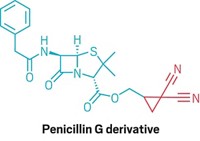Advertisement
Grab your lab coat. Let's get started
Welcome!
Welcome!
Create an account below to get 6 C&EN articles per month, receive newsletters and more - all free.
It seems this is your first time logging in online. Please enter the following information to continue.
As an ACS member you automatically get access to this site. All we need is few more details to create your reading experience.
Not you? Sign in with a different account.
Not you? Sign in with a different account.
ERROR 1
ERROR 1
ERROR 2
ERROR 2
ERROR 2
ERROR 2
ERROR 2
Password and Confirm password must match.
If you have an ACS member number, please enter it here so we can link this account to your membership. (optional)
ERROR 2
ACS values your privacy. By submitting your information, you are gaining access to C&EN and subscribing to our weekly newsletter. We use the information you provide to make your reading experience better, and we will never sell your data to third party members.
Synthesis
Cycloadditions Made Easy
Lewis acid-base chemistry drives fast, flexible construction of substituted benzenes
by Jyllian Kemsley
June 4, 2012
| A version of this story appeared in
Volume 90, Issue 23
Engineered reagents with a Lewis acid-base combination facilitate benzene ring construction reactions, according to a report (Angew. Chem. Int. Ed., DOI: 10.1002/anie.201200917). Conventional [4+2] synthesis of substituted benzene rings involves either substitution reactions, which are limited by the dictates of directing groups, or slow cycloaddition reactions that require hours of reaction time at high temperatures. In the new work, a group led by Joseph P. A. Harrity of the University of Sheffield, in England, combined an alkyne with a Lewis acid acceptor and a diene with a Lewis base. The acid and base bring the two reagents together in a complex that yields regiospecific 1,2,3-trisubstituted benzene products in 10 minutes at 40 ºC. The reaction works with a variety of starting materials, including pyridines, azoles, and amides, and in principle can facilitate other directed cycloaddition reactions, such as [3+2]. It also achieves Harrity and colleagues’ goal of synthesizing precursors to benzoxaboroles, which are organic boron compounds of interest for therapeutic use as antibacterial, antifungal, and anti-inflammatory agents.





Join the conversation
Contact the reporter
Submit a Letter to the Editor for publication
Engage with us on Twitter